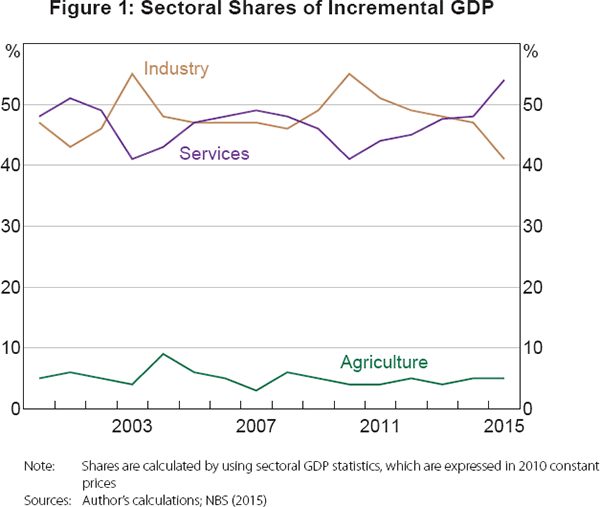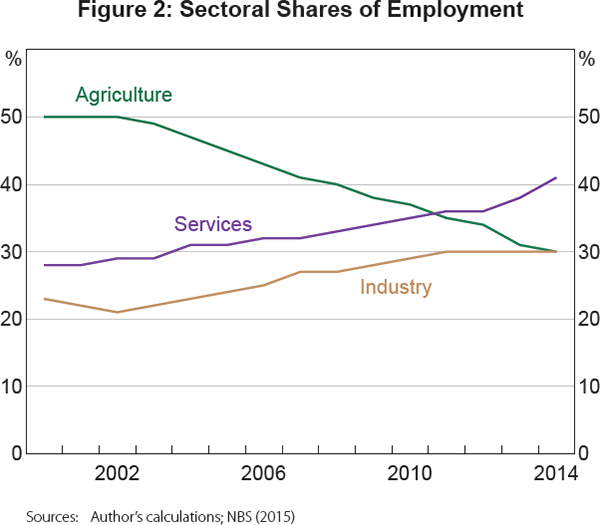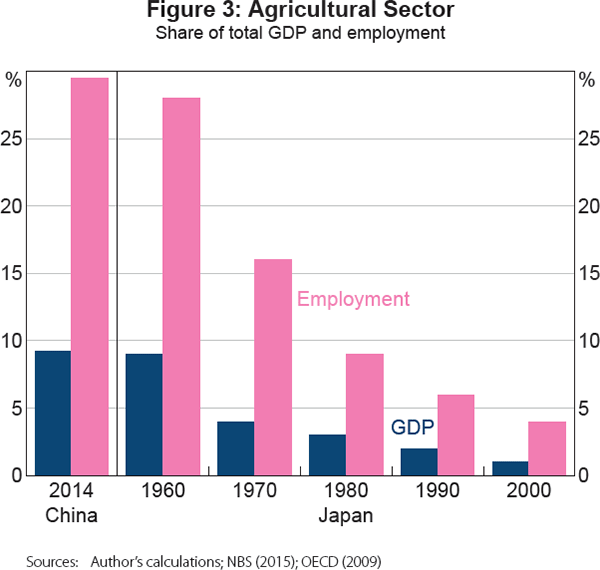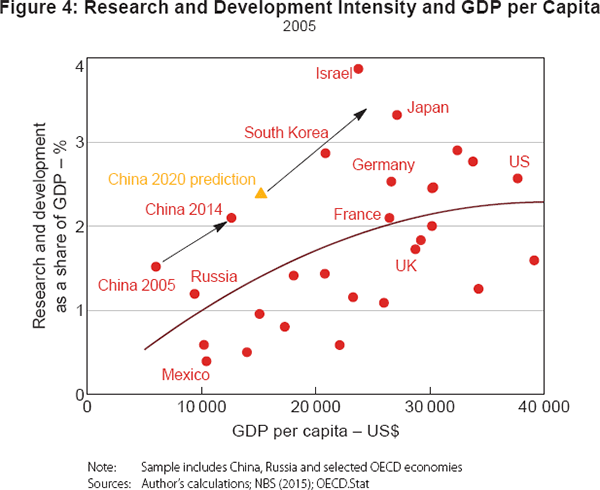RBA Annual Conference – 2016 Discussion
- Download 169KB
1. Yanrui Wu
This paper on China's rebalancing, restructuring and reform by Barry Naughton is very informative and inspiring. Naughton starts with an analysis of aggregate statistics on the Chinese economy and finds no convincing evidence of significant restructuring even though rebalancing has been advocated by the government since 2005. He believes that the lack of rebalancing is due to inconsistent and unsuccessful economic reform policies in recent years. He supports his argument by examining the failure of state enterprise reform and local government debt restructuring. He also argues that the recent adoption of a new policy, ‘supply-side structural reforms’, is evidence of and a logical response to the past reform and policy failure. Nonetheless, while recent efforts have disappointed, he thinks that Chinese policymakers are adaptable and can learn from their experience.
While some authors have pointed to nominal sectoral GDP shares as evidence that the services sector has expanded steadily in China, Naughton argues that the observed trends are almost entirely due to changing relative prices rather than economic restructuring. Figure 2 in Naughton's paper shows sectoral GDP shares based on 2010 constant prices, which, he argues, show no evidence of structural change. I reproduced this figure and confirmed his observation that recent shares of industrial sector GDP are just above those of services sector GDP.
I used the same dataset to calculate sectoral shares of the change in annual GDP, which leads to different interpretations about rebalancing (Figure 1). I want to make two observations about this figure. First, in terms of incremental GDP shares, the services sector exceeded the industrial sector during 2006–08. This trend was, however, derailed by the economic stimulus package of CNY4 trillion (about US$586 billion) initiated in 2008. Second, the services sector share bottomed in 2010 and has since maintained an upwards trend. It caught up with the industrial sector share in 2013 and has since been the largest of the three sectors. Wu (2015) suggests this growth in services is driven by faster total factor productivity growth.

Naughton also supports his argument about the lack of structural change by analysing sectoral employment statistics. The latest official statistics show that services recorded net job creation (17.28 million jobs). By contrast, in 2014 the agricultural sector lost 710,000 jobs and the industrial sector lost 13.81 million (NBS 2015). The author rebutted these job numbers and presented his own estimate of non-farm jobs creation of 5.01 million. While I am not suggesting that official statistics are flawless, I am not convinced about the alternative number proposed by Naughton either. In 2014, urbanisation alone led to a net population increase of 18.05 million in the urban sector, which creates a huge demand for jobs (NBS 2015). In support of his calculations, Naughton pointed to increased enrolment in the higher education sector, which potentially reduces new entrants into the workforce. The higher education sector in China is, however, a substantial source of labour supply. In 2014, 8.1 million students finished high school with 7.2 million being admitted into colleges or universities. In the same year, 6.6 million college graduates entered the job market (NBS 2015). Personally, I think that the employment statistics show clear evidence of structural change in the economy (Figure 2). China's industrial sector employment peaked in 2012, while agricultural employment has been declining since 2003 (NBS 2015).
In 2014, China's agricultural sector had a GDP share of 9.2 per cent while its employment share was still 29.5 per cent. China's situation in 2014 is very similar to Japan's in 1960 (Figure 3). The dramatic decline in Japanese agricultural employment after 1960 implies a formidable task for China to create enough jobs, mainly in services, for rural migrant workers. But it is a task that Japan has already accomplished and, therefore, I think the officially reported employment statistics are probably acceptable.


I generally agree with the author on China's slow progress in reforming state-owned enterprises (SOEs). The implementation of the 2008 economic stimulus package actually reversed the course of SOE reform. If progress is to be made, further reforms should encourage the growth of the private sector, particularly the participation of private and foreign firms in service provision as services are the main driver of economic growth and job creation (Wu 2015). The recently created state capital investment and/or operations companies (SCIOs) may contribute to this process, but the exact role and function of these SCIOs are yet to be tested.
As for local government debt, I agree with the author that restructuring has not been very successful. However, my own research shows that while we should continue to monitor China's local government debt, it is not yet at an alarming level (Wu 2014). Given the current economic downturn, it is unlikely that the central government will enforce strict local government debt policies. There are actually signs of policies being relaxed to simulate spending and investment (The Economist 2016). In my opinion, there is still room for increasing investment in some areas. For example, services sectors, such as education and health care, have experienced under-investment for a long time in China.
Finally, a discussion of China's economic rebalancing should highlight the importance of innovation. Innovation plays a key role in industrial upgrading and, hence, is critical for China's long-term economic growth. Taking an international perspective, it seems likely that China's innovation development will follow the path of Japan and South Korea. Figure 4 demonstrates that, if it does, there is still huge potential for more investment in this area, which could help China catch up with more developed economies.

References
Economist, The (2016), ‘Ore-Inspiring’, The Economist, 12–18 March, pp 15–16.
NBS (National Bureau of Statistics of China) (comp) (2015), China Statistical Yearbook 2015, China Statistics Press, Beijing.
OECD (Organisation for Economic Co-operation and Development) (2009), Evaluation of Agricultural Policy Reforms in Japan, OECD Publishing, Paris.
Wu Y (2014), ‘Local Government Debt and Economic Growth in China’, Bank of Finland Institute for Economies in Transition, BOFIT Discussion Papers 20/2014.
Wu Y (2015), ‘China's Services Sector: The New Engine of Economic Growth’, Eurasian Geography and Economics, 56(6), pp 618–634.
2. General Discussion
Much of the discussion focused on whether rebalancing has been as limited as the paper suggested. One participant questioned the result of a stable share of services in GDP in recent years (in constant price terms). They noted that household disposable income and consumption have risen faster than GDP in recent years and, given Engel's Law, we would expect the services share of consumption to rise. They argued this suggests demand for services should be increasing more rapidly than GDP. The participant also noted that investment in services had increased for at least three consecutive years and accounted for almost 60 per cent of total investment in 2015, which also suggests services have grown relatively rapidly. Another participant agreed that the services share of GDP was unlikely to have been stable in recent years, and questioned whether similar observations could have been made for Japan, South Korea and Taiwan at a comparable stage of their development.
One participant argued that the official data were likely to understate the importance of services, given the difficulties of capturing growth of new sectors, such as e-commerce and internet-related consumer activities. They noted that there has been difficulty in measuring growth of new sectors in the past, with significant upward revisions to growth estimates for 1998–2003 made in 2005 in order to capture new services industries. Another participant agreed there were data limitations in gauging growth in the services sector, with more information available on the industrial sector.
Some participants suggested alternative metrics that could be used to judge the extent of rebalancing. One participant noted that the relative fall in the goods price deflator partly reflected a global decline in capital goods prices, which may have led to an underestimate of the extent of rebalancing in recent years. They suggested an alternative way of assessing rebalancing is to examine the allocation of investment and credit to new industries. Another participant suggested that the share of household income in GDP and the income distribution was a more important metric for assessing the extent of structural change in China. They argued that 2012 was an inflection point for consumption and household income relative to GDP and the Gini coefficient. The participant also noted that this was consistent with strong growth in retail sales, car demand and property demand since 2012. In reply, Barry Naughton argued that he believes there has been some structural change in recent years, but that the evidence is ambiguous, which suggests serious data issues or institutional problems.
There was also discussion around whether the implementation of reforms in recent years has been as disappointing as suggested in the paper. One participant took a more positive view of recent reforms, noting progress on phasing out local government financing vehicles, despite the risk to investment. The participant also argued that the introduction of deposit insurance, licensing of private banks, and opening of interbank markets had been very positive reforms and were significant for financial development. The participant suggested that allowing the shadow banking sector to grow rapidly had increased deposit rates, thereby benefiting households. Another participant argued reforms could have progressed faster than they had and that SOE reform in particular has been slow. However, they noted that reform in China is typically gradual and that there have been some significant changes in policy in the past two years that should be beneficial – for example, financial liberalisation, the removal of the one-child policy and changes to household registration policies. On the topic of reform, Professor Naughton explained that, relative to the benchmarks announced at the Third Plenum in 2013, reform in the past two years has been slow. He suggested that China is facing many policy challenges as growth slows, but that China still has catch-up potential and can learn from the experiences of other countries that have been through similar transitions, such as Japan and South Korea.
On the topic of local fiscal reform, one participant asked whether failure to impose harder budget constraints on local governments was likely to be a temporary or permanent failure. In response, Professor Naughton argued that the errors are likely to be temporary, but that it was difficult to determine the longer-run effects on growth. Another participant thought that it is too early to assess the consequences of the local government debt swap. They suggested that the authorities' actions highlight that the split between monetary and fiscal policy is not as clear as it could be. The participant noted a preference for tighter fiscal policy than the current stance, since expansionary fiscal policy typically benefits SOEs more than the private sector. They also argued that tight monetary policy can hurt the private sector much more than SOEs. Contrary to this view, Professor Naughton argued that it would be beneficial for fiscal policy to be more expansionary in order to support services sector development. In particular, he suggested that the government should increase health spending to help with the transition to a service-based economy. He also noted that if private businesses are to drive the transformation of the Chinese economy, then the authorities need to show support for those businesses.